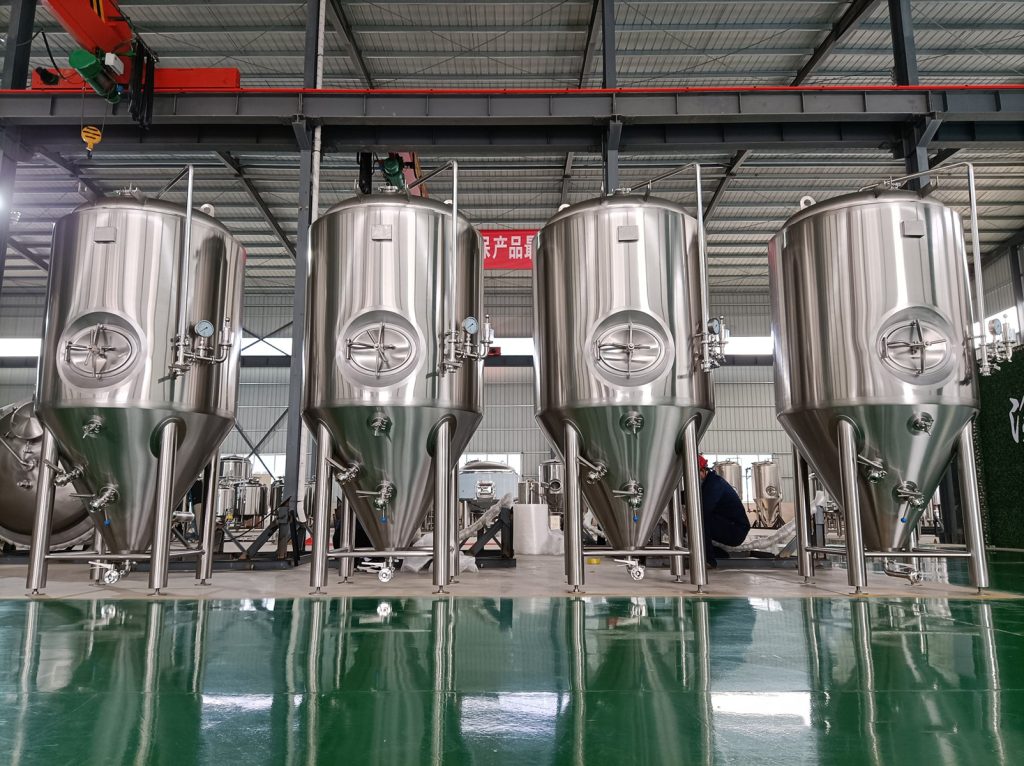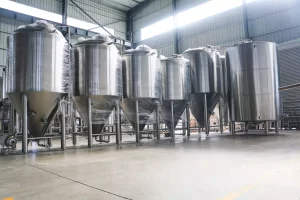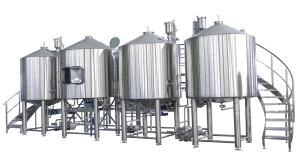¿Cómo calcular el espacio necesario para montar una cervecería?

Poner en marcha una fábrica de cerveza puede ser una aventura apasionante, pero requiere una planificación cuidadosa, sobre todo a la hora de determinar el espacio que necesitará para instalarla. Tanto si va a abrir una pequeña cervecería artesanal como si se trata de una operación comercial de mayor envergadura, saber cuánto espacio necesita es crucial para la eficacia del flujo de trabajo, la seguridad y el crecimiento futuro. En este artículo, le guiaremos a través del proceso de cálculo de la superficie necesaria para gestionar con éxito una fábrica de cerveza.
1. Conozca las distintas áreas de su fábrica de cerveza
Antes de entrar en detalles sobre el cálculo del espacio disponible, es importante identificar las distintas áreas de la fábrica de cerveza. Cada área requerirá una determinada cantidad de espacio, y es esencial tener en cuenta cada una de ellas:
A. Zona de elaboración
La zona de elaboración es donde se produce la magia: aquí es donde se hierve, fermenta y acondiciona la cerveza. El espacio necesario aquí dependerá del tamaño de su sistema de elaboración de cerveza. Un sistema de elaboración de cerveza estándar suele incluir:
- Cuba de maceración
- Túnel de filtrado
- Hervidor de agua
- Tanques de fermentación
Necesitará un espacio amplio para acomodar el equipo y facilitar el movimiento y la limpieza. Por lo general, un sistema de 5 barriles requiere al menos 400 pies cuadrados, pero los sistemas más grandes requerirán más espacio.
B. Área de fermentación
La fermentación es una de las fases más importantes de la elaboración de la cerveza y requiere control de la temperatura y espacio suficiente para los fermentadores. Dependiendo de su volumen de producción, es posible que necesite varios fermentadores, cada uno de los cuales requerirá una cantidad significativa de espacio. No olvides planificar el crecimiento y la escalabilidad en el futuro.
C. Área de envasado
Una vez fermentada la cerveza, hay que envasarla, ya sea en botellas, latas o barriles. La zona de envasado incluye espacio para etiquetar, embotellar y almacenar el producto final. Dependiendo de su capacidad de producción, la zona de envasado puede ser desde un pequeño rincón hasta una sala exclusiva.
D. Almacén y bodega
Es esencial almacenar adecuadamente materias primas como el lúpulo, la cebada y la levadura, así como los productos acabados. También necesitará espacio de almacenamiento refrigerado para mantener frescos los ingredientes y para envejecer la cerveza si tiene previsto elaborar cervezas envejecidas en barrica. Las bodegas de envejecimiento requieren espacio adicional para barriles y estanterías de almacenamiento.
E. Área administrativa y de oficinas
Además del espacio de producción, necesitarás una pequeña zona para tareas administrativas. Podría incluir una oficina para la contabilidad, la planificación y la gestión de las operaciones.
2. Calcule la superficie en función de su escala de producción
La superficie necesaria depende en gran medida del tamaño de la fábrica. Para cervecerías pequeñas, un espacio de 1.000 a 2.000 pies cuadrados puede ser suficiente, pero para cervecerías más grandes, puede necesitar 10.000 pies cuadrados o más. He aquí una guía básica:
- Pequeña fábrica de cerveza (5-20 barriles por lote): Aproximadamente de 1.500 a 2.500 pies cuadrados.
- Cervecería mediana (20-50 barriles por lote): Alrededor de 3.000 a 5.000 pies cuadrados.
- Cervecería grande (más de 50 barriles por lote): Puede requerir 10.000 pies cuadrados o más.
También es importante planificar la expansión futura, sobre todo si prevé crecer después de poner en marcha una fábrica de cerveza.
3. Tener en cuenta el flujo de trabajo y la eficiencia
La eficiencia es la clave del éxito de cualquier fábrica de cerveza. Al planificar el diseño de la cervecería, asegúrese de permitir un flujo de trabajo fluido entre las distintas áreas. Esto incluye:
- Espacio para que los trabajadores puedan moverse entre las zonas de elaboración, fermentación, envasado y almacenamiento sin aglomeraciones.
- Colocación adecuada de los equipos para minimizar el tiempo de transporte de los materiales.
- Espacio adecuado para la limpieza y desinfección.
Una distribución bien planificada reducirá los retrasos operativos y mejorará la seguridad, ayudándole en última instancia a gestionar una empresa más eficiente.
4. Factor de equipamiento y otras consideraciones
No olvide tener en cuenta el tamaño del equipo de elaboración de cerveza a la hora de calcular el espacio disponible. Los sistemas de elaboración de cerveza más grandes, como los automatizados, requerirán más espacio para la instalación, el mantenimiento y la seguridad.
Además, deberá tener en cuenta el espacio necesario para los servicios (electricidad, fontanería, etc.), los sistemas de ventilación y las zonas adecuadas para la eliminación de residuos. Cada uno de estos factores se suma al espacio total necesario para la instalación de la cervecería.
5. Plan de crecimiento futuro
Al poner en marcha una fábrica de cerveza, es posible que no necesite inmediatamente un gran plano, pero es importante pensar en el futuro. Con el tiempo, su cervecería crecerá y su capacidad de producción puede aumentar. Es mejor planificar la futura expansión desde el principio que tener que trasladarse o realizar costosas reformas más adelante.
Deje espacio para futuros fermentadores, recipientes cerveceros más grandes y almacenamiento adicional. Un plano de planta flexible le permitirá ampliar su negocio sin problemas a medida que crezcan sus operaciones.
Conclusión
La puesta en marcha de una fábrica de cerveza es un proceso complejo que requiere una planificación cuidadosa, especialmente cuando se trata de calcular el espacio necesario para su instalación. Si conoce las diferentes áreas de su fábrica de cerveza y calcula el espacio en función de la escala de producción, el flujo de trabajo, el equipo y el crecimiento futuro, podrá asegurarse de que su fábrica funcione de forma eficiente y segura.
Dedicar el tiempo necesario a calcular con exactitud el espacio necesario en planta contribuirá al éxito a largo plazo de su fábrica de cerveza y facilitará los ajustes necesarios a medida que crezca su negocio. Recuerde que el espacio de su fábrica de cerveza no consiste solo en que quepa todo, sino en crear un entorno que fomente la productividad y garantice la calidad de su producto.
Si tiene en cuenta estos consejos a la hora de planificar la instalación de su fábrica de cerveza, estará en el buen camino para poner en marcha una fábrica de cerveza preparada para el éxito.

https://www.tcbrewbeer.com/en/two-vessel-brewhouse-4000l/
https://www.tcbrewbeer.com/en/four-vessel-brewhouse-5000l/
Recomendaciones relacionadas
Sistemas de control de equipos cerveceros: Revolucione su proceso de elaboración de cerveza
185Aumente la eficiencia cervecera con los sistemas de control de equipos de cerveza de Tonsen. Automatice, supervise y optimice la calidad y el ahorro de costes.
Ver detallesPlan de negocio de una cervecería: Su guía definitiva para el éxito cervecero
178Plan de empresa para una cervecería
Ver detallesEl impacto de la cultura de la cerveza artesanal en el diseño del equipo cervecero
309Descubra cómo la cultura de la cerveza artesanal influye en el diseño de los equipos cerveceros con tendencias de personalización, sostenibilidad y automatización.
Ver detalles
 Shandong Tonsenbrew Co., Ltd.
Shandong Tonsenbrew Co., Ltd.





HolaConéctese